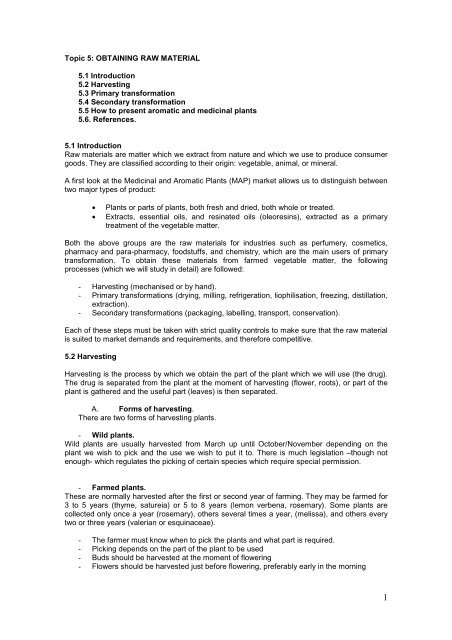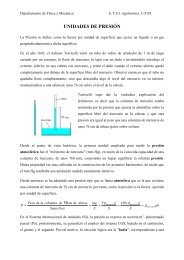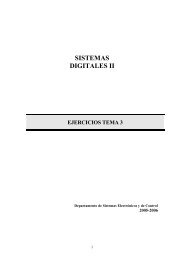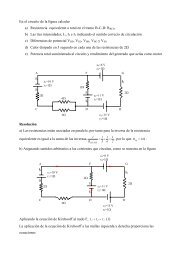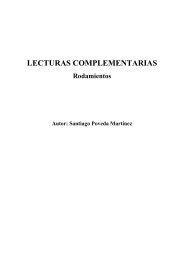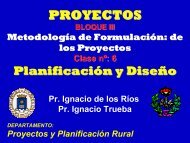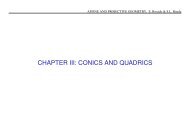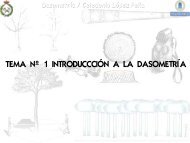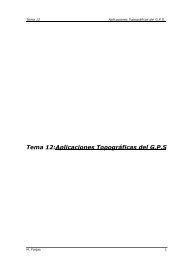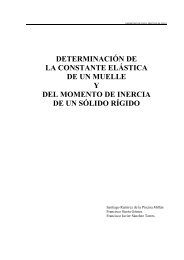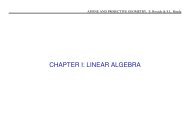topic 5: obtaining raw material - OCW UPM
topic 5: obtaining raw material - OCW UPM
topic 5: obtaining raw material - OCW UPM
You also want an ePaper? Increase the reach of your titles
YUMPU automatically turns print PDFs into web optimized ePapers that Google loves.
Topic 5: OBTAINING RAW MATERIAL<br />
5.1 Introduction<br />
5.2 Harvesting<br />
5.3 Primary transformation<br />
5.4 Secondary transformation<br />
5.5 How to present aromatic and medicinal plants<br />
5.6. References.<br />
5.1 Introduction<br />
Raw <strong>material</strong>s are matter which we extract from nature and which we use to produce consumer<br />
goods. They are classified according to their origin: vegetable, animal, or mineral.<br />
A first look at the Medicinal and Aromatic Plants (MAP) market allows us to distinguish between<br />
two major types of product:<br />
• Plants or parts of plants, both fresh and dried, both whole or treated.<br />
• Extracts, essential oils, and resinated oils (oleoresins), extracted as a primary<br />
treatment of the vegetable matter.<br />
Both the above groups are the <strong>raw</strong> <strong>material</strong>s for industries such as perfumery, cosmetics,<br />
pharmacy and para-pharmacy, foodstuffs, and chemistry, which are the main users of primary<br />
transformation. To obtain these <strong>material</strong>s from farmed vegetable matter, the following<br />
processes (which we will study in detail) are followed:<br />
- Harvesting (mechanised or by hand).<br />
- Primary transformations (drying, milling, refrigeration, liophilisation, freezing, distillation,<br />
extraction).<br />
- Secondary transformations (packaging, labelling, transport, conservation).<br />
Each of these steps must be taken with strict quality controls to make sure that the <strong>raw</strong> <strong>material</strong><br />
is suited to market demands and requirements, and therefore competitive.<br />
5.2 Harvesting<br />
Harvesting is the process by which we obtain the part of the plant which we will use (the drug).<br />
The drug is separated from the plant at the moment of harvesting (flower, roots), or part of the<br />
plant is gathered and the useful part (leaves) is then separated.<br />
A. Forms of harvesting.<br />
There are two forms of harvesting plants.<br />
- Wild plants.<br />
Wild plants are usually harvested from March up until October/November depending on the<br />
plant we wish to pick and the use we wish to put it to. There is much legislation –though not<br />
enough- which regulates the picking of certain species which require special permission.<br />
- Farmed plants.<br />
These are normally harvested after the first or second year of farming. They may be farmed for<br />
3 to 5 years (thyme, satureia) or 5 to 8 years (lemon verbena, rosemary). Some plants are<br />
collected only once a year (rosemary), others several times a year, (melissa), and others every<br />
two or three years (valerian or esquinaceae).<br />
- The farmer must know when to pick the plants and what part is required.<br />
- Picking depends on the part of the plant to be used<br />
- Buds should be harvested at the moment of flowering<br />
- Flowers should be harvested just before flowering, preferably early in the morning<br />
1
- Roots should be harvested in autumn or in winter, or –if we want seeds- just after fruits<br />
appear.<br />
Another important factor to bear in mind is to pick just at the moment when the active ingredient<br />
content is at its highest. For example, valerian is rich in valerenic acids and valepotriates, in<br />
February-March, and the maximum essential oil content is found in September.<br />
Harvesting may be<br />
-Manual (satureia or thyme bunches)<br />
-Semi-manual (lemon verbena leaves)<br />
-Mechanised (thyme, melissa, lavender)<br />
Harvesting should be carried out in such a way that the both the quality and the health of the<br />
product are maintained, always avoiding contamination.<br />
Samples of vegetable matter are collected in the chosen season, before, during, or after<br />
flowering. A complete sample is taken: flowers, leaves, stalks, and roots if we wish to<br />
investigate an active ingredient contained in them.<br />
They are then dried in the air until they reach a constant weight. The leaves, flowers and stalks<br />
are separated into sub-samples which are then weighed. If required, the plants are ground in a<br />
grinder, although this can be done by hand by simply chopping up the plants.<br />
As a general rule, plants should not be gathered when the weather is wet/damp (rain, fog…). It<br />
is better to gather in the morning once dew has evaporated.<br />
• Leaves are gathered when they are young but completely developed, just before the<br />
flowers develop completely (when flowering starts).<br />
• Flowers are gathered when they have opened fully but are still fresh.<br />
• Fruits are collected when ripe.<br />
• Roots should be strong and completely developed.<br />
• Bark is taken from young shoots.<br />
• Grasses are collected when flowering starts.<br />
When harvesting in the field, plants should be harvested without breaking the roots, using<br />
appropriate tools. We should change site regularly so that the plants can regenerate, and we<br />
must not take all the samples of a species from the same place, nor take more than half of the<br />
leaves. Seeds and fruits should be left.<br />
There are certain machines on the market designed and adapted for harvesting certain plants.<br />
In some cases we can use modified cereal harvesters and forage cutters. For small surfaces<br />
(up to 2.5 hectares) we can use a modified cultivator for maintenance and harvesting.<br />
B. Harvesting times<br />
Depending on the species chosen and the intensity of collection, reproductive cycles vary. Mint<br />
or equinaceae may be three years, for example, thyme, oregano and melissa from 4 to 5 years,<br />
lavenders and rosemary from 8 to 9 years.<br />
The period for harvesting starts in May and can last up to October. Certain species are collected<br />
3 or 4 times a season, whereas others can only be gathered once or twice.<br />
The moment for harvesting depends on the part of the plant we are going to use (leaves, seeds,<br />
flowers, or roots), and we should remember that this is a key factor for <strong>obtaining</strong> the quality and<br />
richness in active ingredients we are looking for.<br />
Normally, production starts after one year, but if we plant in autumn, many species are ready for<br />
a first harvest by the following summer.<br />
2
Depending on conditions, we can gather once, twice or three times a year. Thyme, for example,<br />
if irrigated, can be collected three times a year. Oregano once; melissa, like mint, can be<br />
harvested three or even four times; the surface parts of equinaceae three times; estragon twice;<br />
Salvia officinalis three times; Hypericum perforatum twice if irrigated; satureia two or three<br />
times; lavender once.<br />
The rhythm of collection should always keep pace with the rhythm of production or<br />
transformation. Therefore, the harvesting capacity of the machinery used (hectares per day)<br />
should exactly match the capacity of the equipment used for transforming (tons per fresh plant<br />
per day), and the working capacity of the workers available and the collection periods of the<br />
species in question.<br />
C. Post-harvesting processes<br />
The following post-harvesting processes are usual for medicinal plants (for pharmacological<br />
use).<br />
Cutting: this is done to facilitate drying out as it increases the surface evaporation. It depends<br />
on the type of plant and on the technology employed.<br />
Washing: drinking water is used to clean soil and other foreign matter from the part of the plant<br />
which is to be dried<br />
Disinfection: this consists in eliminating micro-organisms which are pathogenic for humans in<br />
different ways, until regulation levels are achieved.<br />
-Chemical: the matter we are going to dry is immersed in chlorinated saline solutions<br />
(sodium hypochlorite, calcium chlorite) so as to reduce the bacterial content to established<br />
authorised levels.<br />
-Physical: the matter we are going to dry is exposed to gamma radiation. This method<br />
is used when chemical disinfection is not efficient or when the vegetable matter comes from<br />
technified areas in which the yield flux is constant and little inorganic matter is present.<br />
Bleaching: this process is used to prevent oxidisation. It consists of a “thermal shock”,<br />
immersing the matter in hot water or steam to inhibit the effect of enzymes responsible for<br />
oxidisation.<br />
Sulphitation: this process aims to preserve natural flavour and colour, help conserve the<br />
vegetable matter, delay loss of vitamins A and C, and counteract the growth of microorganisms.<br />
It consists in placing the vegetable matter in a sulphur dioxide concentrate<br />
(prepared by combustion) of between 1.2% and 2% in a sealed camera for a period of time. We<br />
can also immerse the vegetable matter in a sodium bisulphite or sodium meta-bisulphite<br />
solution; concentrate levels and time periods vary depending on the product.<br />
5.3 Primary transformation<br />
Transformation includes all the processes which allow us to preserve <strong>raw</strong> <strong>material</strong>, choose the<br />
parts to be used, eliminate foreign matter, grind or mill, extract active ingredients (extraction and<br />
distillation), so that the product may be packed and labelled ready for storage or transport. We<br />
must observe the established regulations for correct manipulation.<br />
Gathered matter must undergo a transformation or manipulation process which will depend on<br />
what the end product is to be. The main processes for transformation and preserving are:<br />
-drying and liophilisation if we require a dried plant<br />
-extraction of non-volatile active ingredients<br />
-distillation of essential oils (volatile)<br />
-refrigeration or freezing for fresh and frozen plants respectively<br />
3
a. Drying<br />
The aim is to dehydrate to below 10% and to prevent enzymes from acting; to avoid attacks<br />
from bacteria and fungi, which cause mould and thus a loss of quality. Drying also means the<br />
vegetable matter is easier to transport. There is a problem because not all drugs have the same<br />
degree of humidity. The texture of drugs is also different and this affects the degree of<br />
evaporation. Active ingredients present different reactions to temperature. Drying should be as<br />
fast as possible and should not alter the active ingredient. After drying we must measure<br />
humidity which must not be below 10%. The method used will depend on the nature of the drug,<br />
its humidity, consistency, and the type and quality of the active ingredient. Alkaloids are more<br />
resistant than glycosides and sugars. Due to their volatility, essential oils cannot be dried at high<br />
temperature. There are three methods: air, heat, and vacuum.<br />
Drying in air.<br />
This process is used in countries with a warm, dry climate, for small quantities of drugs whose<br />
active ingredients are stable. Drying is carried out in the shade as the sun would cause<br />
photosynthesis in the drug. The drug is protected from night-time humidity. Drying takes place in<br />
closed but ventilated rooms, the drug being spread out in thin layers. The process is slow, and<br />
desiccation into the air may occur.<br />
Drying by heat.<br />
This is the commonest method used and has the advantage that we can control the two factors<br />
which affect good desiccation: temperature and ventilation. We need to ensure a rapid<br />
elimination of humidity without changing the active ingredient. If the temperature is high, a rapid<br />
surface evaporation takes place and a dry layer appears which prevents further drying. Drying<br />
by this method is usually at 30-40 degrees, or 60-70 degrees for bark, always depending on the<br />
active ingredient. Ventilation ensures that air is in contact with the drug up to water saturation<br />
point. Once the air is saturated it is changed. Small scale drying takes place in ovens with air<br />
vents, and industrial drying takes place in drying tunnels. The latter have a heater at one end<br />
and a fan at the other. The drug is placed in the tunnel on trolleys with several shelves, so as to<br />
achieve progressive drying. As the trolley moves along the tunnel the heat it is subjected to<br />
diminishes.<br />
This drying operation is used industrially: the drying areas are designed and built for a specific<br />
quantity and type of vegetable matter which is to be treated.<br />
The conditions (temperature and humidity) for this process depend, particularly, on the species<br />
to be treated. The water content of the vegetable matter which we are going to dry is of primary<br />
importance, as is its capacity for water retention, the maximum drying temperature, and the<br />
humidity in the air we are going to use. When calculating the capacity of the drying equipment<br />
we should take into account the amount and volume of the fresh vegetable matter we wish to<br />
dry in a certain time.<br />
When producing dried plants we can use both natural drying (which takes longer and requires<br />
more space) by hanging or on trays, or forced drying, which involves blowing hot, dry air around<br />
a sealed area to extract moisture and cold. It is much faster, though this depends on the<br />
moisture of the plant. Appropriate drying temperatures are between 32 and 35 degrees, so as<br />
not to destabilise the active ingredients nor the volatile essences. It is best to reduce drying time<br />
to avoid this.<br />
Post-drying<br />
Once we have dried the plant, we must separate the part we want to use and eliminate the<br />
others and also any foreign matter (soil, stones).<br />
The separation process can be done using machines with sieves, or air tubes which separate<br />
different densities using air currents. If we add magnets we can also separate metals.<br />
Later, depending on purpose or presentation, we can:<br />
-mill (powders for capsules or tablets, condiments…)<br />
4
-grind (tins, tea-bags…)<br />
Once the vegetable matter is dry (10-11% moisture content) it can be stored without risk of<br />
biological processes degrading its active ingredients.<br />
b. Liophilisation.<br />
This process involves dehydration by freezing. The vegetable matter is subjected to very low<br />
temperatures (-30, -80) so that the water freezes into fine crystals. The ice is then sublimated in<br />
a vacuum.<br />
c. Refrigeration.<br />
Refrigeration maintains organoleptic qualities and appearance. For the process to be efficient,<br />
we must reduce the temperature quickly to avoid loss of moisture. The optimum temperature is<br />
2 to 9 degrees.<br />
Commercial uses are:<br />
Fresh leaves for cooking: basil, coriander, estragon, thyme, laurel, melissa, mint, rosemary,<br />
salvia, etc…<br />
Edible flowers: pansies, thistle, calendula, courgette…<br />
d. Freezing.<br />
When freezing, we should bear in mind that plants lose texture when frozen. However, it is<br />
excellent for pre-cooked meals where aroma and taste are important.<br />
Frozen products last up to 6 months in a fridge, and between 10 and 12 months in a more<br />
powerful freezer and in freezer bags.<br />
The best plants for freezing are: basil, garlic, celery, estragon, thyme, mint, parsley, marjoram,<br />
lemon verbena, oregano, rosemary, satureia, salvia and melissa.<br />
e. Distillation.<br />
This process of transformation allows us to obtain essential oils. These are oily substances<br />
made up of a large number of complex chemical compounds which are aromatic but highly<br />
volatile.<br />
Producing essential oils depends on the species, the variety, the environment and conditions of<br />
growing, the years of cultivation, and on the distilling process itself.<br />
Distillation is a very simple physical process, and the usual method is to use dragging by steam.<br />
This process does not require sophisticated equipment, and guarantees a good yield of good<br />
quality essence. A distillation set consists of:<br />
• A heater<br />
• A distillation flask<br />
• A cooling tube<br />
• A Florentine flask<br />
The fresh vegetable matter (which may be dried slightly) is placed in the distillation flask making<br />
sure that it is evenly distributed. Once full, the flask is hermetically sealed and steam is passed<br />
through the bottom at a certain pressure. The steam opens the glands where the oil is stored<br />
and drags it out, forming an emulsion of steam and oil droplets. This passes through the cooling<br />
tube where it condenses into water and oil. This mixture is then put into the Florentine flask<br />
where the two liquids separate due to their different density.<br />
When choosing a distillation set we must bear in mind:<br />
• The amount of plant to be distilled<br />
• The harvesting period of the species to be distilled<br />
5
Essential oils obtained using this process can be stored for long periods of time in appropriate<br />
conditions (darkness, at a temperature between 12 and 15 degrees, in galvanised jars…)<br />
f. Extraction.<br />
This process involves subjecting fresh or dried plant matter to the effects of one or more<br />
solvents so as to obtain a liquid or solid which contains the active ingredients.<br />
It can be carried out in normal atmospheric conditions, in a partial depression, or in the<br />
presence of a gas. Industrial processors use simultaneous extraction, extraction in line, or<br />
extraction in constant flux, employing one or more solvents. They have a built-in solvent<br />
recycler.<br />
Extraction is a chemical process that uses different solvents (with more or less polarity) to<br />
obtain a liquid that contains the active ingredient we want. Water has limited extraction power<br />
compared with other solvents used. The most commonly used of the latter is alcohol of different<br />
degrees. Many extracts are carried out using this solvent. Other solvents include ether,<br />
chloroform, acetone, propilengricol…<br />
5.4 Secondary transformation. Packing and labelling.<br />
Secondary transformation consists in packing and labelling the <strong>raw</strong> <strong>material</strong>.<br />
a. Packing.<br />
Packaging isolates the <strong>raw</strong> <strong>material</strong> from external influences. We can use:<br />
• Paper<br />
• Kraft paper sacks<br />
• Polypropylene, polyamide<br />
• Wooden or cardboard boxes<br />
Oils are put in topaz glass or in aluminium-lined containers. Polyethylene, polypropylene and<br />
polyvinyl chlorate are not suitable as they absorb the essential oils.<br />
b. Labelling.<br />
Labels identify the <strong>raw</strong> <strong>material</strong>. They must contain at least the following information:<br />
• Name in Latin<br />
• Common name (this varies locally)<br />
• Plant part used<br />
• Presentation<br />
• Batch number<br />
• Place and date of collection<br />
• Use-by date<br />
• Supplier´s name<br />
• Net weight<br />
The invoice is the documentation that comes with the product. It identifies and defines the<br />
product and allows us to confirm delivery to the client. It should contain the following<br />
information:<br />
• Supplier´s name<br />
• Supplier´s address<br />
• Product name<br />
• Batch number<br />
• Total weight of batch<br />
• Number of packets, bottles…<br />
• Order number<br />
• Invoice number<br />
• Date<br />
6
To sum up, the conditions in which secondary transformation takes place also affect the quality<br />
of the product. We should therefore keep the following in mind:<br />
-if adequately dried, products can be transported and preserved without loss of quality,<br />
maintaining organoleptic characteristics, active ingredient content, moisture, and microbiology…<br />
-the type of container affects quality, preservation, and cross-contamination.<br />
-correct labelling allows us to identify the product and avoid mistakes.<br />
-appropriate manipulation during secondary transformation ensures that the quality at the time<br />
of growing and harvesting is maintained.<br />
c. Preservation.<br />
Quality preservation depends basically on two things: storage and transport.<br />
i) Storage.<br />
The harvested product must be stored in such conditions that quality, health and innocuousness<br />
are maintained until the product reaches the consumer. Adequate storage prolongs the product<br />
usefulness. We should concentrate on two basic factors which affect end quality:<br />
-the type and conditions of the storage area<br />
-factors which affect the product during the process and period of storage<br />
Storage of plants is usually in paper or hessian plastic sacks, or in boxes. We should prevent<br />
fresh plants from fermenting. Each sack/package should be labelled with the name of the<br />
producer, the species, presentation, and date of harvesting.<br />
In many cases the drug is sterilised (ethylene oxide) to prevent micro-organisms. Changes may<br />
happen during storage: oxidisation due to the air, reactions due to heat, changes in the<br />
appearance of the drug due to light, or the appearance of mould due to humidity.<br />
If the drug is very hygroscopic, a drying agent is usually added in a net. Drugs should be stored<br />
in dry, ventilated, shady places, at a low temperature, away from insects. Metal boxes are better<br />
than plastic ones. It is better to store the drug whole and pulverise it at the moment of use.<br />
Drugs may not be kept indefinitely, and usually last one or two years. Barks last three or four<br />
years.<br />
• Storage installations.<br />
Storage installations should be designed and built so that they are:<br />
-high above the ground, fresh, clean, and well aired.<br />
-protected from insects and rodents.<br />
-at a temperature of < 20 degrees.<br />
-with regulated light and humidity (
Existing stores or new designs should take steps to ensure that installations or specific areas<br />
are impermeable to gas, so that fumigation of species may be carried out on site.<br />
• Factors which affect storage<br />
Light. Most plants lose colour when exposed to light, especially leaves and flowers. Moreover,<br />
active ingredients degrade more rapidly.<br />
Temperature. The cooler the store, the better the preservation of <strong>raw</strong> <strong>material</strong>s is. Heat favours<br />
loss of essential oils. It also attracts insects and causes microbiological contamination.<br />
Humidity. This has two negative effects: it activates certain enzymes, especially glycocidates,<br />
and increases contamination by fungi, mould and yeasts.<br />
Size of ground matter. The smaller the ground product, the greater the surface exposed to<br />
external factors. This is particularly important for plants which contain essential oils (mint,<br />
camomile), tannins (mahogany, witch hazel), or bitter ingredients (centaureae, gentiana).<br />
A dry room is the best place to keep <strong>raw</strong> vegetable <strong>material</strong>, at a temperature below 10<br />
degrees, and with less than 60% humidity.<br />
ii) Transport<br />
Products may spoil when manipulated or transported. We must ensure that harvested products<br />
keep their innocuousness and wholesomeness. Transport should be as quick as possible and<br />
conditions should be the same as those for storage to avoid deterioration.<br />
• General considerations.<br />
Products should be protected from the effects of the weather when we transport them to prevent<br />
contamination or deterioration.<br />
Vehicles used for transporting products should be thoroughly clean and dry at the time of<br />
loading and, preferably, disinfected.<br />
It is best to load and unload during the daytime, because at night artificial lighting attracts<br />
insects which may get into the containers. Loading and unloading should be carried out in<br />
places sheltered from the weather and pollution, and away from the processing area.<br />
The load should be secured firmly while transporting, to stop it moving as this may deteriorate<br />
the quality.<br />
Vehicles used for transport should be parked and kept away from the product processing area<br />
to avoid pollution from exhaust fumes.<br />
When large loads are carried it is best to ensure there is dry air ventilation to eliminate moisture<br />
formed by the plants´ respiration and to avoid condensation forming each time the vehicle<br />
passes from a warm area to a colder one, or a dry area to a wetter one, or if travelling during<br />
the night.<br />
It is best to pre-establish loading and unloading areas.<br />
Containers should be handled with care to make sure they do not break and that the product is<br />
not damaged.<br />
When transporting mixed loads, we should consider their compatibility (smell, pollution,<br />
colour…) and make sure that there are no toxic substances. We must also bear in mind<br />
different temperature and humidity requirements.<br />
8
We should check the vehicle carefully, making sure there are no cracks or other gaps which<br />
might let water in, and that the locks work properly.<br />
The vehicle should not be parked in direct sunlight during stops. It is also better not to stop next<br />
to other vehicles or machinery which emit fumes.<br />
• Treatment<br />
Pest control (rats, insects) allows us to keep the store hygienic. We should specify the<br />
pesticides used for this purpose and the time and date of use.<br />
The European Commission has passed regulations on the use of radiation for disinfecting<br />
vegetable species using γ rays (cobalt, pollutes the environment) and β rays (electron<br />
bombardment, less pollution but it releases ozone into the atmosphere).<br />
Other disinfectant methods used include:<br />
-in some countries the use of chloroform, ethylene, and propylene oxide is permitted.<br />
-we can use nitrogen, although certain humidity results and can cause fungi to appear.<br />
-steam sterilization (at 110 degrees for two hours).<br />
-ozone (results have not been good).<br />
-bromure, hydrogen phosphure and pesticides (pyretrines) eliminate worms and moths.<br />
-at present the use of CO2 is being investigated with very positive results.<br />
• Stability and duration<br />
By stability we mean the amount of time an active ingredient keeps in certain conditions. We<br />
establish stability by investigating this. Each <strong>raw</strong> <strong>material</strong> has a different period of stability.<br />
• Process of <strong>obtaining</strong> the product: technical information<br />
Producers must enclose a technical information sheet with the <strong>raw</strong> <strong>material</strong>, describing how it<br />
was obtained and treated. The following facts should be included:<br />
- Harvesting<br />
• Latin name and variety of the plant<br />
• Part of the plant used<br />
• Place of origin<br />
• Growing and harvesting methods<br />
• Time of harvesting and vegetative state of the plant at the time<br />
- Drying<br />
• Drying method, temperature and time of exposure<br />
- Storage<br />
• Conditions and duration of storage<br />
• Packing <strong>material</strong>s<br />
- Transport<br />
• Duration and conditions of transporting the product<br />
- Treatment<br />
• Phytosanitary treatments: products used, how and when<br />
The producer and distributor may send their suppliers a questionnaire or even visit a supplier to<br />
check: the questionnaire asks about:<br />
- Organisation<br />
- Staff<br />
- Installations<br />
- Equipment<br />
- Documents and paperwork<br />
9
- Work methods<br />
- Flow of <strong>material</strong>s<br />
- Quality control<br />
- Production<br />
- Store<br />
This information is essential to establish a quality guarantee for the <strong>raw</strong> <strong>material</strong>, and to<br />
establish trust in suppliers. It also gives us a complete picture of processes.<br />
5.5 Presentation of MAP <strong>raw</strong> <strong>material</strong><br />
The basic transformation <strong>raw</strong> vegetable matter is subjected to depends on the commercial<br />
product we want to make, and the industrial sector it will be used in. the table below shows<br />
certain commercial products that can be obtained and the transformations they require.<br />
Initial Product End Product Transformation<br />
Fresh plants<br />
Table by: M. T. López – Ajero, 2007.<br />
Fresh plants Washing, disinfection, packing<br />
Dried plants Chopping, drying, sieving<br />
Frozen plants Washing, disinfection, freezing<br />
Liofilised plants Freezing, sublimation<br />
Essential oils Grinding, airing, distillation<br />
Extract Grinding, airing, extraction<br />
Oleoresin Dehydration, extraction, evaporation<br />
Fresh plants<br />
A whole harvested plant which has not been dried<br />
Essential oils<br />
These are the main aromatic products that can be found in different parts of plants. Because<br />
they evaporate in air at room temperature they are variously known as: volatile oils, ethereal<br />
oils, essential oils, or essences. They are aromatic products which we obtain from <strong>raw</strong><br />
vegetable matter by distilling, usually using water or steam. In the case of citrus fruits they are<br />
obtained using a mechanised process: squeezing.<br />
Extracts<br />
In botanical medicine, an extract is the maximum concentration of a plant that is made by<br />
extraction with a solvent. Extracts may be in the form of tinctures, liquid extracts, solid extracts,<br />
and powdered extracts. Quality is usually expressed as an intensity quotient of 1:1 or 1:2, or<br />
established according to standards if it is a compound or group of chemical compounds.<br />
• Powdered extract<br />
Powdered version of liquid or solid extracts in the USA Pharmacopoeia, it is prepared by<br />
evaporating liquid content. The concentrate quotient is between 1:1 and 10:1 or even more.<br />
• Solid extract<br />
Liquid extract in the USA Pharmacopoeia, concentrated by evaporation or vacuum<br />
extraction. It has a dried grass quotient of 4:1.<br />
10
• Standardised extract<br />
Powdered extract prepared by evaporation. Nevertheless, it contains a “standard” amount<br />
of a plants main component. The active ingredient is identified and guaranteed.<br />
An extract which contains a specific amount of a certain chemical compound or of a group<br />
of chemical compounds which are supposedly active. Extracts which contain a high<br />
concentrations of active chemical products from a pharmacological point of view, are<br />
produced depending on the physical and chemical properties of the compounds using<br />
appropriate solvents (water, ethanol, methanol, hydro-alcoholic mixes…) at predetermined<br />
temperatures.<br />
• Complete extract<br />
This contains the complete spectrum of ingredients originally present in the plant, as well as<br />
the active compounds which are formed during the process.<br />
• Liquid extract (USA Pharmacopoeia)<br />
Alcoholic or hydro-alcoholic preparation with a dried or fresh plant content of 1:2.<br />
Spice oleoresins. These are obtained from spices dried by extraction using a volatile, nonaqueous<br />
solvent, followed by solvent elimination by evaporation at moderate temperatures<br />
and in a partial vacuum. In Spain, Paprika oleoresin is produced for use in the foodstuffs<br />
industry.<br />
Dry plants<br />
Dry drugs may be in the form of:<br />
- Roots: valerian, genkian, bardana, dandelion, arnica, liquorice<br />
- Plant: nettles, dandelion, aniseed, horsehair<br />
- Leaves: mint, lemon verbena, estragon<br />
- Petals: damask rose, malva<br />
- Seeds: coriander, aniseed, cumin<br />
- Bark: Cinnamon<br />
- Stamen: saffron<br />
- Tambrils: maize<br />
- Flowers: camomile, arnica, elder<br />
- Buds: cloves<br />
- Fruits: lemons, nutmeg, juniper<br />
Frozen plants<br />
Cryo-conservation is widely used in the pharmaceutical industry. This process consists in<br />
preparing, conserving, and keeping a product for a long period of time at an ultra-low<br />
temperature (-196 degrees), using liquid nitrogen (LN). This process allows us to manipulate the<br />
product without losing volatile active ingredients.<br />
An associated process is cryo-grinding: this is the pulverisation of the active part of a dried plant<br />
which has been cryo-conserved. This process gives us a homogeneous powder (cryo-ground<br />
powder) which allows the phytotherapist to obtain an optimum and constant activity. Cold is<br />
used for this process because recent studies have shown that traditional grinding causes<br />
temperature to increase which deteriorates the volatile substances, vitamins, enzymes, and<br />
many active ingredients<br />
Liophilized plants<br />
These plants are fresh plants which have been dehydrated by freezing. In contrast with drying,<br />
these plants have not been subjected to heat, and so certain molecules (such as vitamins)<br />
maintain their properties and are no destabilised. Royal jelly, for example, is commercialised<br />
using this process. Also Aloe Vera gel.<br />
11
5.6 References<br />
ALBERT LLANA, F. J. y ALBERT VERNAL, A. (1998): Producción de plantas aromáticas y<br />
medicinales en la Unión Europea, Comunitat Valenciana Agraria, nº 11.<br />
FERNANDEZ-POLA, J. (1996): Cultivo de plantas medicinales, aromáticas y condimenticias,<br />
Ediciones Omega, S.A. Barcelona.<br />
IBAÑEZ, Carlos (1999): «La Normalización internacional de aceites esenciales», Técnicas de<br />
Laboratorio, número 220, abril.<br />
MUÑOZ, Fernando (1999): Cultivos industriales: productos farmacéuticos y aromáticos,<br />
Investigador principal del INIA para el «Curso de especialización en producción y<br />
comercialización de plantas aromáticas y medicinales», Madrid.<br />
Guía de Buenas Prácticas de Higiene y Agrícolas para la producción primaria,<br />
acondicionamiento, almacenamiento y transporte de productos aromáticos.<br />
http://www.herbotecnia.com.ar/bpa-y-bpm.html<br />
12


